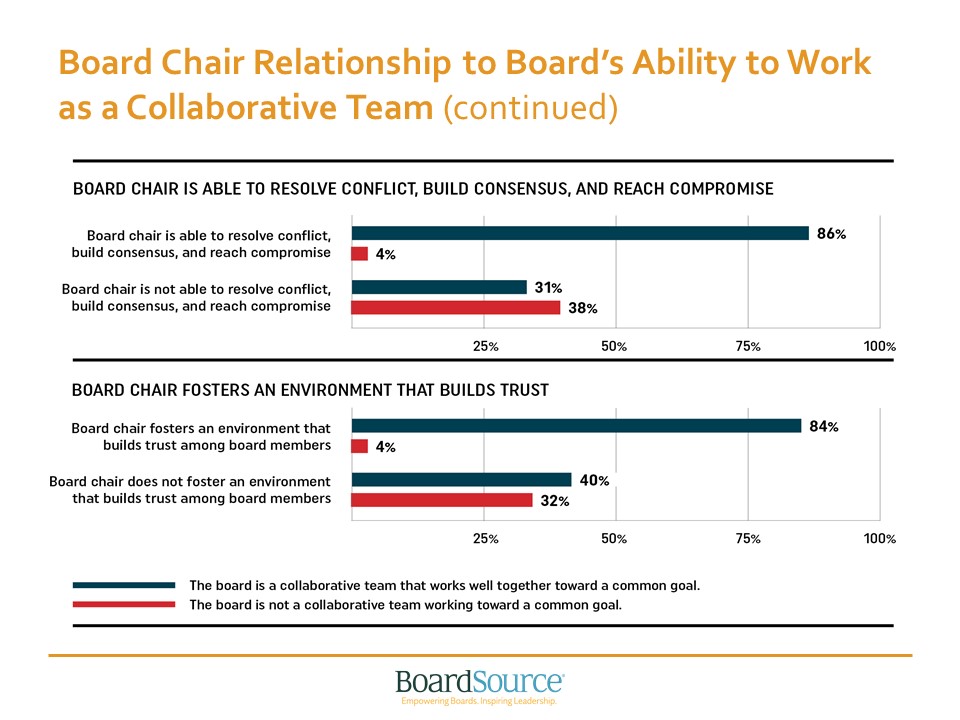Since the board of directors is ultimately responsible for the governance and direction of a non-profit organization, the role of board chair is rather crucial. Recently Non-Profit Quarterly hosted a webinar titled, “The Pivotal Role of the Nonprofit Board Chair: Beyond Meeting Facilitation” which was based on the results of Board Source’s recent Leading With Intent study.
As you might imagine, the leadership the board chair exhibited set the tone for the way the entire board operated, which in turn had an impact upon the job satisfaction experienced by the organization’s executive leader.
They boiled the characteristics necessary for an effective board chair down to four areas: Establishes Clear Expectations of Board Service; Encourages Board Members to Frame and Discuss Strategic Questions; Ability to Resolve Conflict, Build Consensus and Reach Compromise; and Fosters An Environment That Builds Trust.
The following two slides from the slide show (available for download) illustrate that impact. When the board chair exhibits these characteristics, the impact on board effectiveness is clear. When the board chair is unable to do so, there is an almost equal chance the board will fail to work collaboratively.
The toughest job a board chair seems to have is establishing clear expectations of board service. When asked to grade their board chairs in the Leading With Intent study, 30% of organization executives gave their chairs an A grade versus 41% giving chairs A grades in conflict resolution and encouraging strategic discussions and 51% giving an A for fostering an environment of trust. Twenty-five percent of executives gave their chairs a D grade in establishing clear expectations, the largest margin in any category.
The webinar leaders fielded a number of questions from participants about conflicts between chair and board members as well as chair and executive officers, offering some general advice in each case. One of the main points they emphasized was the importance of recruiting for leadership qualities. Every board member should be evaluated for their potential to take a leadership role, if not eventually assuming the chair position.
They also said if your organization has a position which is designated to be the next chair (President-elect, Vice chair, etc), the board should be willing to vacate the process if it becomes apparent that the person in that position is not suited to assume the chair position. They acknowledge this can be difficult to do given the social relationships that likely exist both internally and externally to board service.

This being said, The Council of Non-Profits suggests the chair-in-waiting model as an important tool in being “A Rockstar Board Chair.” Their concept of the chair presumptive goes beyond just shadowing the chair at committee and board meetings.
However, rather than leave the learning to a volunteer board member’s own initiative, why not be proactive and create a new practice that intentionally supports the success of your nonprofit’s current and future board chairs? Most boards “orient” their volunteer board members early in their tenure. Why not organize a special orientation for your nonprofit’s board chairs? Past board members/past board chairs may be excellent mentors since they’ve had some time to think about what they might have done differently, or what worked and why.
The Council of Non-Profits article recognizes the importance of many of the same characteristics mentioned in the Leading With Intent study: building trust, managing group dynamics and encouraging discussion about the organizational mission.
They discuss other roles a board chair serves on behalf of the organization so anyone wanting to become a Rockstar Board Chair or cultivate them in their organization would do well to review the NPQ webinar and Council of Non Profits article.

